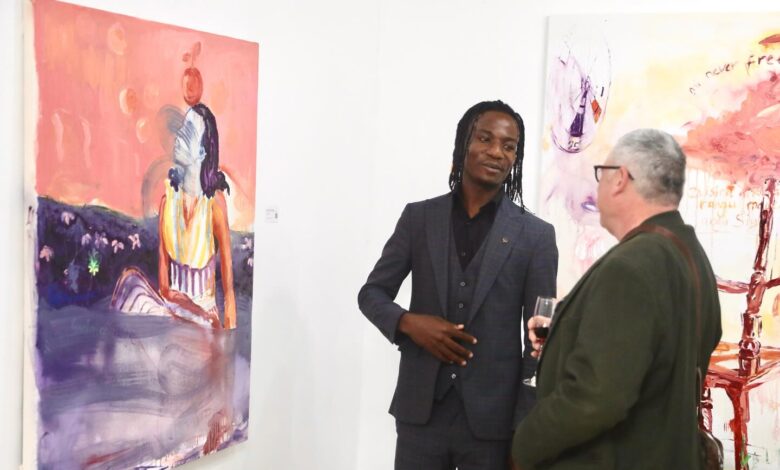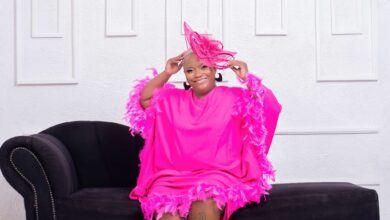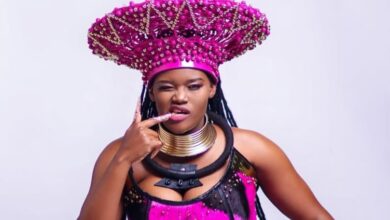Kusvika Parizvino: Again Isheanopa Chokuwamba Challenges the Body Taboos Rooted in Religion and Culture

Across generations and cultures, the human body has been burdened with shame, guilt, and silence. Many religions and traditional customs have twisted ideas of purity and morality to frame the body and its natural sexuality as something vulgar, sinful, and impure—something to be hidden or suppressed in order to elevate the spirit. This enduring taboo has not only denied people a full experience of their humanity but also created deep psychological and cultural wounds.
In his latest solo exhibition Kusvika Parizvino, on display at First Floor Gallery (FFG), visual artist Again Isheanopa Chokuwamba confronts this inherited discomfort head-on. His work dives into the politics of flesh, bone, and blood, challenging audiences to reconsider what has long been labelled as indecent or profane. With an approach that feels both youthful and fearless, Chokuwamba paints the body not as a source of shame, but as a powerful vessel of emotion, memory, and identity.
This is not Chokuwamba’s first exploration of nudity. In his 2024 debut solo exhibition, Drowning in My Senses, he positioned the nude form at the centre of his artistic language. But even then, his intention was never provocation for its own sake. He described his process as playing with “elements that closely represent human ecology”—a phrase that captures his interest in how the body interacts with nature, society, and emotion.
FFG curator and co-founder Valerie Kabov described his early work as “poignant, joyous, uncertain.” That sense of uncertainty becomes a powerful device in Kusvika Parizvino, which translates roughly to “reaching this point.” The title reflects not only Chokuwamba’s artistic journey but also the inner evolution of someone peeling back layers of social conditioning. Since his debut, he has exhibited at notable events such as FNB Art Joburg and Kuvhunura at The Blachère Foundation in France, steadily gaining momentum without rushing the process. As Kabov noted in 2024, “he is in no rush to achieve because he is in this for the long haul.”
In Kusvika Parizvino, Chokuwamba continues his intimate exploration of carnal experience, often through the lens of female subjects. His work reflects the awkwardness and curiosity of young adulthood, where sensuality, emotional complexity, and bodily awareness begin to fully unfold. In Vakorinde Vekutanga, a couple shares a quiet, emotionally tense moment in what appears to be a bedroom. The woman sits upright with her hands in her lap while the man reclines beside her, propping his head up as if trying to understand her silence. The title, which references the Bible, adds layers of meaning—suggesting the emotional tension tied to religious expectations about marriage and intimacy.
In I Do, a woman gazes out from the canvas, adorned with flowing hair, floral garlands, and a delicate halo. The portrait evokes purity, commitment, and longing, inviting interpretations that span from idealised love to a desire for spiritual connection through the body. Meanwhile, Mvura Yehupenyu (“Water of Life”) depicts a gender-ambiguous figure standing in a body of water, surrounded by vegetation. Here, water becomes a symbol of life and rebirth, suggesting that true vitality is found in embracing, not rejecting, the physical self.
Yuh Love features a couple in a semi-nude post-coital moment, captured in a scene that feels at once sacred and awkward. The imagery may call to mind the biblical story of Adam and Eve discovering their nakedness and shame after eating the forbidden fruit—but in Chokuwamba’s version, it is a moment of reflection rather than guilt. Other pieces like Kamera Nyanga and Country Roads are more playful, even provocative. They depict exposed pubescent subjects and carry a mischievous tone that flirts with street language and youth culture. While some may draw comparisons to the works of Balthus and other Western artists who depicted similar themes, Chokuwamba’s gaze is rooted in a different context—one that speaks directly to the experience of a young African man navigating a world still shaped by colonial and religious control.
What makes Chokuwamba’s work distinctive is how he fuses raw emotional expression with a streetwise sensibility. His titles often evoke the language of everyday life—suggesting not high-minded art theory but lived experience, whispered jokes, and vulnerable confessions. His characters feel less like idealised figures and more like people pulled from memory or dreams. They seem to rise from the canvas like visions—part ghost, part desire, part truth.
Though young, Chokuwamba demonstrates a rare emotional intelligence. His work captures the tension of growing up in a society that teaches young people to fear their bodies while simultaneously exploiting them. Through his art, he claims the right to feel, to desire, to be uncomfortable—and to be seen. Kusvika Parizvino is more than a continuation of his early work. It is a bold refusal to be silenced, a celebration of the human form in all its complexity, and an invitation to confront the shame that so many of us have been taught to carry.
In his own quiet way, Again Isheanopa Chokuwamba is creating a new visual language—one that speaks to the body not as a problem to be solved, but as a story to be honoured.




